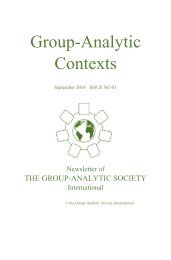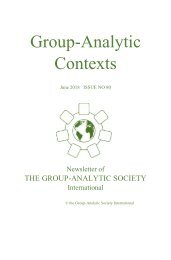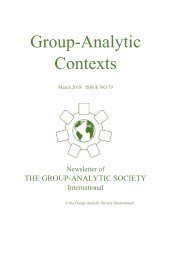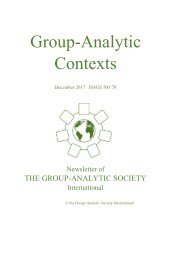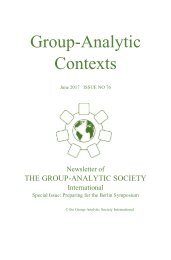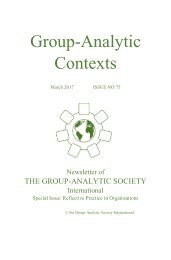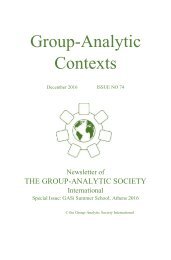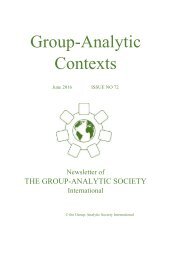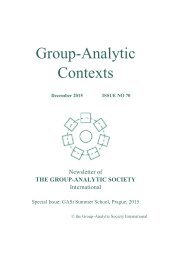Group Analytic Contexts, Issue 77, September 2017
Newsletter of the Group Analytic Society International
Newsletter of the Group Analytic Society International
Create successful ePaper yourself
Turn your PDF publications into a flip-book with our unique Google optimized e-Paper software.
Newsletter – Autumn <strong>2017</strong> 109<br />
enough’ and when is it likely to be achieved? In Bionian terminology,<br />
when transformation of beta-into alpha-elements occurs. The former<br />
are thoughts without thinking, in search of a thinker. In the group,<br />
psychotic members can be helped to transform primal psychotic<br />
dependence on the mother (or group) into more creative and symbolic<br />
thinking. Some of Koukis’ patients spent 8-10 years in group therapy.<br />
If this feels long, lengthy treatment periods are not uncommon for<br />
chronic and severe conditions (schizophrenia; psychosis; personality<br />
disorders) within psychoanalysis and GA.<br />
Koukis conceptualises schizophrenia in a traditional<br />
psychoanalytic way. He cites research studies throughout his book,<br />
asserting that depression in such patients can be treated “effectively”<br />
in an analytic group. Considering that ‘schizophrenia’ is a<br />
heterogenous condition, this claim is perhaps too ambitious. Whilst<br />
the presented case of Nikos certainly makes for an interesting read,<br />
the idea that patients with depressive symptoms cope in their transition<br />
from the paranoid-schizoid to the depressive position in an autodestructive<br />
way and, therefore, may benefit from a group, is perhaps<br />
less convincing. There are many confounding factors (e.g.<br />
medication). And as much as I would like to believe in the supremacy<br />
of the group analytic method over cognitive behavioural therapy, I<br />
remain sceptical.<br />
In his chapters on dreaming in psychosis, Koukis rejects<br />
some neuropsychological theories of hearing voices. Instead, he<br />
favours Freud’s explanation (voices are defence mechanism; if<br />
derogatory, they emanate from a harsh superego). Patients with<br />
psychosis are thought to be unable to dream. However, they can<br />
rediscover the ability to produce ‘proper’ dreams as their therapy<br />
evolves in his heterogenous analytic group. <strong>Group</strong> analytic<br />
phenomena (mirroring, communication, sharing experiences in freefloating<br />
discussions in the group) foster the narration of dreams in the<br />
dreaming group matrix. This may lead to “decompensation of patients’<br />
super-invested pre-conscious”. In turn, a reconstitution of their ability<br />
to dream occurs. This description is as heart-warming as it gets.<br />
Koukis shows that patients’ ability to dream is enhanced by the dreamlike<br />
similarity between the act of hearing voices and the dream matrix<br />
of the group. His phenomenology and ontology of dreaming in<br />
psychosis is most certainly unique. The interweaving of<br />
neuropsychological studies and case presentations in his arguments<br />
makes for an excellent read. Unfortunately, their abrupt appearance<br />
may be disconcerting for those readers without prior knowledge of<br />
neuropsychology.



